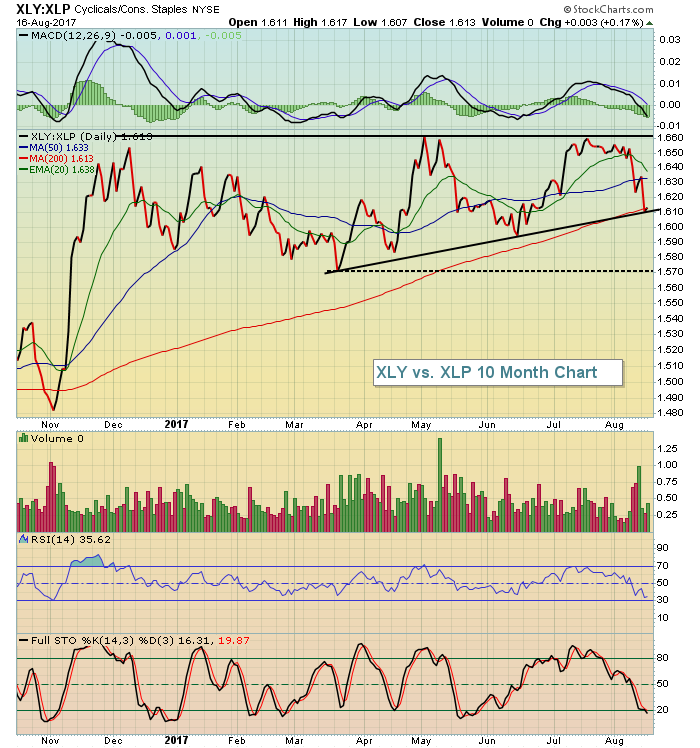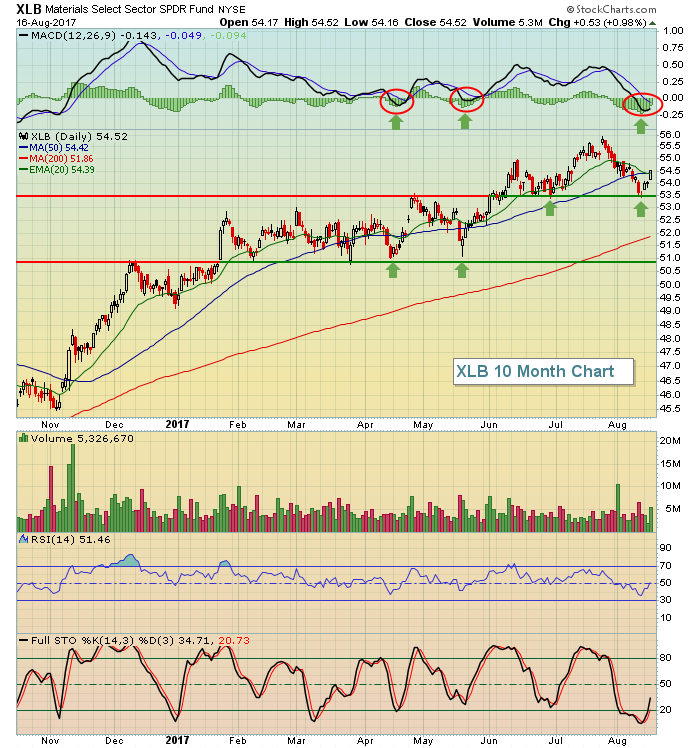Market Recap for Wednesday, August 16, 2017
All of our major indices finished higher on Wednesday and seven of our nine sectors finished higher as well. The primary laggard on the session? Energy (XLE, -0.96%). Go figure. A significant reason for the XLE's renewed relative weakness has been the reversal in crude oil prices ($WTIC). Since opening the month above $50 per barrel, black gold has fallen throughout August, including four of the last five trading sessions - and that recent weakness has broken the short-term uptrend that was established during the six weeks that concluded at the end of July:
 Previous trendline breaks have resulted in an onslaught of selling and lower crude oil prices. It's hard to bet against another round of selling in the WTIC, especially with the XLE breaking down beneath price support just below 64 this week.
Previous trendline breaks have resulted in an onslaught of selling and lower crude oil prices. It's hard to bet against another round of selling in the WTIC, especially with the XLE breaking down beneath price support just below 64 this week.
But there's a bigger issue technically surrounding the overall market and that's multiple failed breakout attempts on the NASDAQ 100 - the strongest of our key indices throughout 2017 - at the 5935 level. I wrote about the reversal there early last week and we saw immediate selling ensue with volatility soaring. We could be preparing for a similar move now. Here's the current view of the NDX on a very short-term basis with key support/resistance highlighted:
 Futures are pointing lower this morning and we're nearing the end of the seasonally strong 11th-18th period of the calendar month. Furthermore, the upcoming period from the 19th through the 26th is the weakest time of the calendar month so there's plenty of technical and seasonal reasons to be a little cautious right now.
Futures are pointing lower this morning and we're nearing the end of the seasonally strong 11th-18th period of the calendar month. Furthermore, the upcoming period from the 19th through the 26th is the weakest time of the calendar month so there's plenty of technical and seasonal reasons to be a little cautious right now.
Pre-Market Action
Dow Jones futures are lower this morning by 53 points as Cisco Systems (CSCO) failed to impress with its quarterly results after the bell last night. This morning, it's Wal-Mart's (WMT) turn to underwhelm.
European markets are lower this morning as well, putting pressure on the bulls here in the U.S.
Current Outlook
One of my favorite ratios to follow the underlying health of the stock market is consumer discretionary vs. consumer staples (XLY:XLP). A rising ratio is bullish while a declining ratio is bearish. Key breakouts or breakdowns in this ratio that correspond to strength or weakness in the benchmark S&P 500 can be quite telling. The current pattern in this ratio is bullish:
 There's an ascending relative triangle in play currently so a reversal at the current relative support would be a very bullish development. A breakdown? Well, I'd look to the recent relative low near 1.57. If that holds, I'm fine with the action. A breakdown, however, beneath 1.57 could lead to much more selling ahead in the S&P 500.
There's an ascending relative triangle in play currently so a reversal at the current relative support would be a very bullish development. A breakdown? Well, I'd look to the recent relative low near 1.57. If that holds, I'm fine with the action. A breakdown, however, beneath 1.57 could lead to much more selling ahead in the S&P 500.
Sector/Industry Watch
Materials (XLB, +0.98%) surged on Wednesday to lead the stock market higher, but more significantly, the sector was able to bounce off key price support this week:
 This is also a perfect illustration of why the MACD is a secondary indicator for me, secondary to price support/resistance. Notice the red circles highlighting bearish MACD crossovers? They weren't truly bearish as price support (green arrows) was never lost. It's the combination that's powerful. If price support holds, I remain bullish during uptrends regardless of what the MACD does.
This is also a perfect illustration of why the MACD is a secondary indicator for me, secondary to price support/resistance. Notice the red circles highlighting bearish MACD crossovers? They weren't truly bearish as price support (green arrows) was never lost. It's the combination that's powerful. If price support holds, I remain bullish during uptrends regardless of what the MACD does.
Historical Tendencies
I mentioned above that the 19th to 25th days of the calendar month are bearish. On the S&P 500 (since 1950), these collective days have produced annualized returns of -8.24%. While you might say "the 19th to the 25th is only a week's worth of trading", keep in mind that this week has occurred once a month for the past 67 years. The total number of trading days is approaching 4000 and is the equivalent of 16 years worth of data. If I told you that the S&P 500 would average losing 8.24% for each of the next 16 years - through 2034 - would that matter to you? As a trader, it's paramount to recognize the historical tendencies and they are just tendencies. The stock market is not guaranteed to move lower from the 19th to the 25th. It's a historical tendency. This period does result in gains as well. But given the summer months that we're in, which also tend to be weak, and the fact that we have negative divergences across so many weekly charts, I'd at least recognize the potential for short-term weakness ahead.
On the NASDAQ, the 19th and 20th have produced annualized returns of -29.55% and -34.41%, respectively. The good news? August 19th and 20th fall on Saturday and Sunday this year. :-)
Key Earnings Reports
(actual vs. estimate):
BABA: .94 vs .73
GRFS: .27 vs .28
WMT: 1.08 vs 1.07
(reports after close, estimate provided):
AMAT: .83
GPS: .52
ROST: .76
Key Economic Reports
Initial jobless claims released at 8:30am EST: 232,000 (actual) vs. 240,000 (estimate)
August Philadelphia Fed Survey released at 8:30am EST: 18.9 (actual) vs. 17.0 (estimate)
July industrial production to be released at 9:15am EST: +0.3% (estimate)
July capacity utilization to be released at 9:15am EST: 76.7% (estimate)
July leading indicators to be released at 10:00am EST: +0.3% (estimate)
Happy trading!
Tom
